

Identity cards (ID Cards) war. Gas masks during the war - ww2. By September 1939 some 38 million gas masks had been given out, house to house, to families.
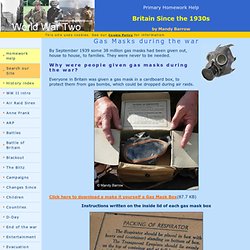
They were never to be needed. Everyone in Britain was given a gas mask in a cardboard box, to protect them from gas bombs, which could be dropped during air raids. Click here to download a make it yourself a Gas Mask Box(87.7 KB) Instructions written on the inside lid of each gas mask box Gas had been used a great deal in the First World War and many soldiers had died or been injured in gas attacks. There was a fear that it would be used against ordinary people at home in Britain (civilians). Posters reminded people to carry their gas mask at all times. A poster remindng people to lways cary their gas masks The masks were made of black rubber, which was very hot and smelly. Woman wearing a gas mask The smell of the rubber and disinfectant made some people feel sick. Army Gas Mask Mickey Mouse childs gas mask To tell people that it was all clear they would ring a bell.
Children's Gas Masks. Primary History - World War 2 - Wartime homes. Primary History - World War 2 - Food and shopping. Rationing - World War II (1939-45) After the outbreak of war only essential foods were imported into Britain.
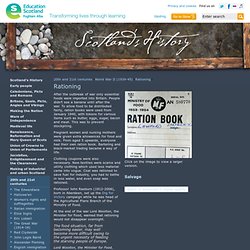
People didn’t see a banana until after the war. To allow food to be distributed fairly, ration books were used from January 1940, with tokens for various items such as butter, eggs, sugar, bacon and meat. This was to prevent stockpiling. Pregnant women and nursing mothers were given extra allowances for food and milk. From aged 5 upwards, everyone had their own ration book. Clothing coupons were also necessary. Professor John Raeburn (1912-2006), born in Aberdeen, set up the Dig for Victory campaign while he was head of the Agricultural Plans Branch of the Ministry of Food. At the end of the war Lord Woolton, the Minister for Food, warned that rationing would not disappear overnight.
The food situation, far from becoming easier, may well become more difficult owing to the urgent necessity of feeding the starving people of Europe. Lord Woolton, the Minister for Food, 1944. Weekly Ration. Dried Egg. Ration Book. Poster 1. Primary History - World War 2 - Children at war. What was the home front? Britain was called the 'Home Front', because people felt that they were part of the war.
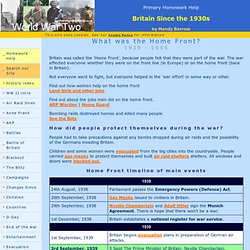
The war effected everyone whether they were on the front line (in Europe) or on the home front (back in Britain). Not everyone went to fight, but everyone helped in the 'war effort' in some way or other. Find out how women help on the home front Land Girls and other jobs Find out about the jobs men did on the home front. ARP Warden | Home Guard Bombing raids destroyed homes and killed many people. People had to take precautions against any bombs dropped during air raids and the possibility of the Germans invading Britain. World War 2 Jobs. The job of most men during World War 2 was that of a soldier.
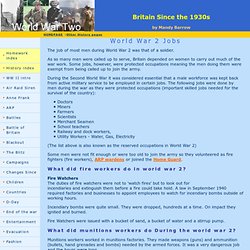
As so many men were called up to serve, Britain depended on women to carry out much of the war work. Some jobs, however, were protected occupations meaning the men doing them were exempt from being called up to join the army. During the Second World War it was considered essential that a male workforce was kept back from active military service to be employed in certain jobs. The following jobs were done by men during the war as they were protected occupations (important skilled jobs needed for the survival of the country): Primary History - World War 2 - Air raids - the Blitz. APR Wardens during World War 2. ARP (air raid precaution) wardens supervised the Blackout.
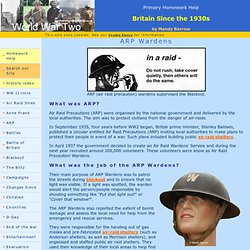
Air Raid Precautions (ARP) were organised by the national government and delivered by the local authorities. The aim was to protect civilians from the danger of air-raids. In September 1935, four years before WW2 began, British prime minister, Stanley Baldwin, published a circular entitled Air Raid Precautions (ARP) inviting local authorities to make plans to protect their people in event of a war.
Such plans included building public air raid shelters. In April 1937 the government decided to create an Air Raid Wardens' Service and during the next year recruited around 200,000 volunteers. Shelters. Sheter 5. Shelter 2. Shelter 4. Shelter 3. Posters. Poster 3. Poster 4. Poster 7. Poster 6. Poster 5. Poster 2.